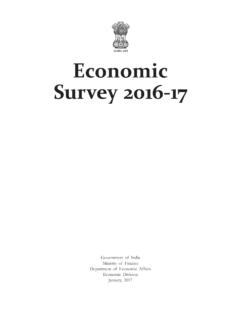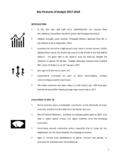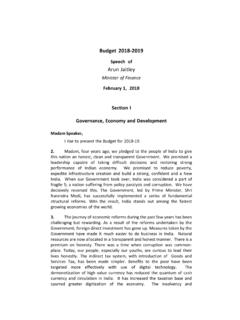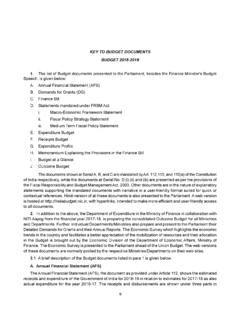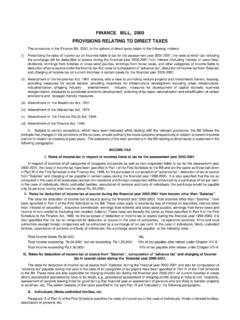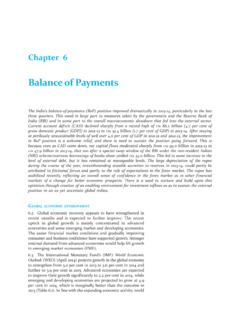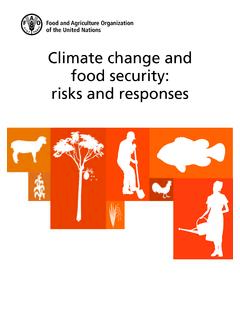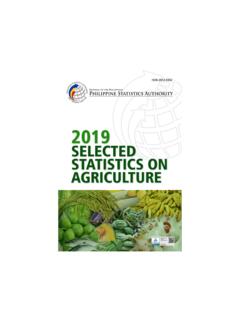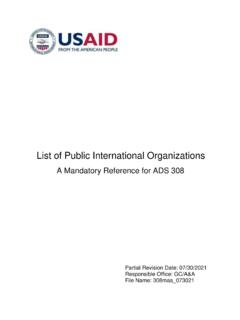Transcription of CHAPTER
1 CHAPTER07 Climate change is primarily attributed to disproportionately high cumulative emissions, both historical and high per capita annual emissions of greenhouse gases (GHGs) of the developed countries. The global nature of the problem makes India one of the most vulnerable regions despite having contributed only about 4 per cent in the cumulative global emissions (for the period 1850-2019) and maintaining its per capita emission at far less than the world average. While India is less responsible for the high stock of emissions, however, it has consistently engaged in demonstrating global leadership towards adopting various measures and ensuring a low-emission growth pathway with a commitment to the net-zero emissions goal by 2070. India has integrated the development goals with ambitious climate action goals, be it in the form of augmented solar power capacity (installed), higher energy saving targeting notified in PAT cycle-VII, improved green cover facilitated by Green India Mission, among other targeted Government actions.
2 As part of dedicated efforts to preserve ecosystems, India now has 75 Ramsar sites for wetlands, in addition to various regulatory and promotional measures to protect and conserve mangroves. Continued river conservation and rejuvenation efforts are underway through Namami Gange and National River Conservation Plan (NRCP).In August 2022, the country updated the Nationally Determined Contributions (NDCs) in line with the Hon ble PM s vision expressed in the 26th meeting of the Conference of Parties of UNFCCC. In terms of transition to renewable energy sources, India has already achieved its target of 40 per cent installed electric capacity from non-fossil fuels ahead of 2030. It has advanced the target to 50 per cent, which shall also translate to a significant reduction in the average emission rate. The National Hydrogen Mission and Green Hydrogen Policy have been introduced to enable India to be energy independent by 2047.
3 Its pivotal role is also reflected in India s Long Term Low Emissions Development Strategy (LT-LEDS). The availability of adequate and affordable finance remains a constraint in India s climate actions. The country has so far largely met its requirements from domestic sources only. Finance is a critical input for its climate actions. Therefore, the country has scaled up its efforts towards mobilising private capital, including through sovereign green bonds, to meet climate action goals. A framework for the latter has been issued in compliance with International Capital Market Association (ICMA) Green Bond Principles (2021).India s initiatives on the international stage have been noteworthy. The country has actively engaged in global actions by championing the formation and strengthening of various intergovernmental organisations. CLIMATE CHANGE AND ENVIRONMENT: PREPARING TO FACE THE FUTURE217 Climate Change and Environment: Preparing to Face the Climate change is the long-term change in temperature and weather patterns that can occur due to natural reasons, but since the beginning of the industrial revolution in the 19th century, it has been predominantly due to anthropogenic activities.
4 GHG emissions remain in the atmosphere for tens to hundreds of years, trapping the sun s heat from escaping. While within limits, these make our earth more habitable, allowing for salubrious weather conditions, the enhanced emissions have led to rising temperatures with the potential to bring about sea level rise, change monsoon cycles and impact land systems. GHG emissions are the most significant threat to humanity and the inescapable reality the world faces. Action to reduce carbon emissions and adapt to the changing climatic conditions are required urgently as the world has already started to experience its consequences. For instance, it is estimated that by 2030, about 700 million people worldwide will be at risk of displacement by drought alone ( SDG Portal). Thus, global warming is a reality, and so is climate change. Nor is there much doubt that human activity is primarily responsible for it this time, although climate change occurred in the distant past even when Planet Earth was scarcely populated.
5 Despite agreement on the above, there can still be much divergence about what comes next and what to do about it when it comes to climate change. Much of the global angst associated with climate change is about the emission of GHGs and carbon, in particular. The more GHGs are emitted, the more they stay trapped in the atmosphere, accelerating global warming. Hence, the argument goes that if some of the cataclysmic consequences are to be avoided, then global warming must be arrested, slowed and, if possible, reversed. One way to strive for it is to reduce emissions of GHG, including carbon. Many nations pledge to reduce their net emission to zero by 2050. Some wish to achieve it by 2060 and by : Net Zero Pledges of countries (the Year pledged is on top of the bars) 2060 203020352040204520502055206020652070 Pledged Net-zero Year 2050 2070 2053 2045 Source: Emissions Gap Report 2022, UNEP218 Economic Survey However, this is where things begin to get interesting.
6 Science is not very clear on whether further emission reduction would necessarily guarantee a stoppage or reversal of global warming. The reason being much carbon dioxide and other GHGs have already been emitted over the last two and half centuries of industrialisation-led economic growth in today s advanced nations, principally in North America and Europe. The share of developing countries in the stock of GHGs (usually measured as carbon dioxide equivalent) has been minimal compared to developed countries. This is corroborated by the Inter-Governmental Panel on Climate Change (IPCC), which highlights that the challenges faced due to global warming are mainly due to cumulative historical and current GHG emissions of developed countries. The impact of the accumulation would also be iniquitous, with the developing countries not only bearing the brunt of climate change but also constrained by their capacity to respond to its challenges.
7 The IPCC s Sixth Assessment Report (AR6) notes that high human vulnerability global hotspots are found particularly in West, Central & East Africa, South Asia, Central, and South America, Small Island Developing States, and the Arctic. Further, as per the report, Asia is most vulnerable to climate change, especially to extreme heat, flooding, sea level rise, and erratic rainfall. Ironically, the burden of adaptation is highest for those who have contributed the least to global warming. That unfortunate inevitability means that the stock of GHGs in the atmosphere may have already set a train of events that future emission reduction could do very little to stop or reverse. Even if the answer to this question is unclear or unknown, some correctly argue that not doing whatever we can to make the planet more liveable and less dangerous may amount to criminal negligence. The problem is that the people and nations making this argument have their priorities correct for themselves but not for the countries yet to climb the ladder of prosperity.
8 It is an enduring principle of economics that resources have competing uses and that there are always trade-offs. Today s developing nations are therefore caught in the horns of a dilemma. How much resources to devote to bread-and-butter developmental priorities and to adapting to the already changing climate, and how much to dedicate to mitigating emissions of GHGs? Today s developed nations have prospered through the unrestricted use of fossil fuels, including coal, crude oil, and natural gas. It is theoretically elegant to argue that switching to renewable or non-fossil fuel energy would generate investments and jobs. Still, it seldom works out so smoothly in practice. For example, China has declared that future energy supplies, including alternative ones, must be secured first before dispensing with existing energy sources. Countries might find themselves not scrapping coal-fired power plants, and the alternatives may be held up either due to a lack of technology, financial resources, skilled and trained human resources, or some combination of all three.
9 Countries have also learnt that the jobs that are likely to be created in the so-called green economy are tilted towards skill and technology-intensive than in traditional One may also argue that it may be easier to speak of retraining and relocating people than actually doing World Economic Outlook, October 2021, World Economic Outlook, October 2021: Recovery During A Pandemic ( )219 Climate Change and Environment: Preparing to Face the Nobel Laureate Thomas Schelling (2005) argued that the most effective way to combat climate change was to let nations grow first2: If per capita income growth in the next 40 years compares with the 40 years just past, vulnerability to climate change should diminish, and the resources available for adaptation should be greater. I say this not to minimise concern about climate change but to anticipate whether developing countries should make sacrifices in their development to minimise the emission of gases that may change the climate to their disadvantage.
10 Their best defence against climate change may be their own continued development. That economic growth would enable resource generation will come as no surprise to students of corporate finance. Companies generate profits and internal resources and thus fund their investments. For companies worldwide, the single biggest source of finance for their capital investments is their own resources before they turn to markets. That would work for nations too. Another reason why it is a realistic proposition is that securing funding from either developed nations or multilateral organisations is rather difficult. Public finances in developed countries are stretched and do not seem to have the intent to mobilise adequate resources for climate action in developing countries. They also do not have the appetite to provide additional capital to multilateral institutions for them to be able to lend more or mobilise greater resources. Further, the willingness and incentives-alignment of the private sector to undertake long-gestation projects are questionable at best or non-existent at worst.

